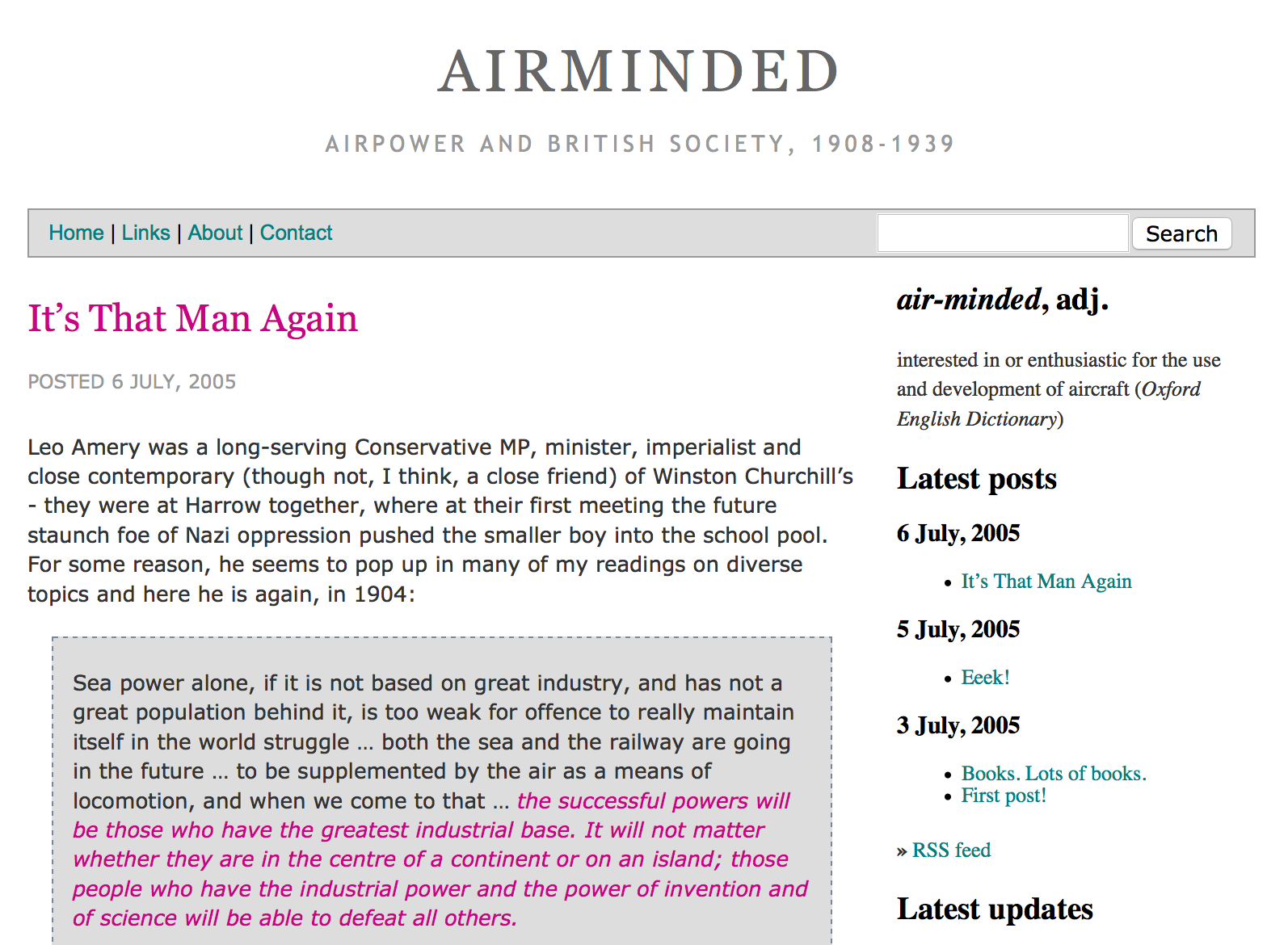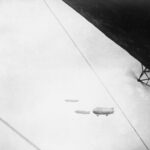It’s quite a small world tour, admittedly, but two gigs in two countries just qualifies, I think. Little to no moshing is expected.
First, I will be giving a paper at the Empire in Peril: Invasion-scares and Popular Politics In Britain 1890-1914 workshop, which is being held at Queen Mary University of London on 14 and 15 November 2013. I’ll be reprising my Wellington AAEH paper, with the following title and abstract:
‘What are the Germans up to?’ The British phantom airship scare of 1913
In late 1912 and early 1913, people all over Britain reported seeing airships in the night sky where there were none. The general presumption was that these were German Zeppelins, testing British defences in preparation for the next war. One result was a largely Conservative press agitation for a massive expansion of Britain’s aerial forces, perceived to be completely outclassed by Germany’s in both number and power. In many ways this panic was analogous to the much better known 1909 dreadnought scare (itself followed by a smaller phantom airship scare). But historians now generally agree that 1913 was a period of detente in Anglo-German relations. Why, then, did Britons not only imagine that German airships were a potential threat, but imagine that they were actually flying overhead?
As an example of collective behaviour, the phantom airship scare offers us a rare glimpse of the state of British public opinion (as well as press and political opinion) regarding Germany shortly before the outbreak of the First World War. I will place this scare in the context of the preceding dreadnought, spy and invasion panics, and will argue that the threatening nature of the new technology of flight, and Britain’s perceived failure to keep pace with other nations in its military applications, amplified the German threat despite the improving international situation. In particular, I will show that the airship scare was also a naval scare: navalists argued that Germany, having lost the dreadnought race, was building Zeppelins at a furious rate in order to overcome British naval superiority and that Britain was losing a new, aerial arms race of which it was barely even aware. 1913 may have witnessed detente at the official level, but the British press and public were still less than ready to believe in Germany’s good intentions.
So, the usual, in other words. But what’s really exciting is that I won’t be the only one talking about phantom airships or air scares! I’m speaking in a session entitled ‘The Terror from Above’ along with Michael Paris who is speaking on ‘Aerial Invasions’; and afterwards there is a keynote and plenary by Michael Matin on ‘The 1913 Airship Panic and the Cultivation of Fear’. At last, I have found my people! Of course, we’ll probably vehemently disagree with each other but that’s okay too. Given the topic, the rest of the workshop will also be fascinating, and on the evening of 14 November there’s also a public lecture by Nicholas Hiley, intriguingly entitled ‘Vernon Kell’s perfect nightmare: The German invasion of Britain in 1914’. See, didn’t I say that this was the best conference topic ever?
I’ll also be giving a paper at The British Empire and the Great War: Colonial Societies/Cultural Responses conference, which is being held at Nanyang Technological University, Singapore, on 19-22 February 2014. This time I’ll be expanding on my Adelaide AHA paper, with the following title and abstract:
Mystery Aeroplanes and the Colonial State of Mind in Total War
In the autumn of 1918, mysterious aeroplanes were seen in the skies of Australia and New Zealand. Hundreds were reported by men and women, young and old, civilians and soldiers. It was presumed that they were German aircraft flying from unknown merchant raiders or from secret inland aerodromes. Investigations by authorities revealed that the aeroplanes were phantoms, but for a time they appeared to pose a real threat.
After nearly four years of war, both countries were largely defenceless, with the vast majority of their military forces overseas and little more than poorly-equipped training cadres remaining at home. In March 1918, newspapers carried reports that the German merchant cruiser Wolf, which had been raiding Australian waters the previous year, had flown its seaplane over Sydney undetected and unopposed. A few days later, Germany’s Spring Offensive nearly broke the Allied lines for the first time since 1914. The mystery aeroplanes resulted from the sudden fear that the Antipodean home fronts were now directly threatened and that the war could be lost.
I will discuss what the mystery aeroplane scare reveals about the state of mind of the people of Australia and New Zealand after nearly four years of total war.
This is a big conference: the keynote speakers alone are John MacKenzie, Hew Strachan, Tim Barringer and Jay Winter. There’s much less airpower history on offer (only me) than in London, but you can’t have everything, I suppose.
I’ll be in London for at least two weeks, perhaps three from 9 November, researching in various archives and sightseeing at various attractions. (I might travel outside London or even the UK for the third week, but it won’t exactly be holiday weather.) So, apart from the actual workshop dates of 14 and 15 November there will be opportunities for Airminded social activities, should there be sufficient interest. It’s been four years since my last visit to the UK so there is catching up to do. Suggestions please!
![]() This work is licensed under a Creative Commons Attribution-NonCommercial-NoDerivatives 4.0 International License.
Permissions beyond the scope of this license may be available at http://airminded.org/copyright/.
This work is licensed under a Creative Commons Attribution-NonCommercial-NoDerivatives 4.0 International License.
Permissions beyond the scope of this license may be available at http://airminded.org/copyright/.




Stuff the world tour, I’ll be an Wagga in 2 weeks, and you’ve moved further away!
Congratulations on the conferences.
I found this by accident while looking for something completely different:
http://www.flightglobal.com/pdfarchive/view/1909/1909%20-%200510.html
I thought the use of the term ‘scareship’ was particularly interesting.
The tourist agencies seem a bit slow in getting off their hindquarters, so I’d suggest the RAF Museum, which has had a lot of additions over the last few years, the Science Museum (the Treasury fluidic computer may still be on display, unless they’ve repossesed it as they don’t seem to be doing that well with the new-fangled electric ones). You could fit in a trip to Chatham and not see a phantom airship, but part of the dockyard is now a museum, supposedly excellent. And while in London, the one place not to miss is Paris; just a short hop on the train! Musee de l’Air; big lumps of real airship – need I say more? I think we can guarantee cool weather; and almost certainly no bush fires.
Congratulations, by the way!
Errol:
I was going to say that I was just in Wellington which is closer to you than Wagga would be to here; but in fact it’s not. New Zealand isn’t as small as it might seem!
Kym:
Thanks for that — I hadn’t come across that before. There was at least one phantom airship report from Staffordshire, but certainly not very many. Of course it’s not clear from that article whether the airship/balloon was in any way real. Still, it’s an interesting little glimpse into the semi-fraudulent/semi-naive world of the airminded inventor at this time; much like the death ray men later.
Ian:
I’ve done the RAF Museum and the Science Museum, though that was back in 2007; as you say they’ve probably come along since then. Chatham’s not a bad idea — I had been thinking of going to Portsmouth on my last trip but didn’t make it, maybe Chatham is easier to get to from London? As for Paris, I was already thinking along those lines! I’ll be teaching the Revolution soon and getting a feel for where it all happened would be no bad thing.
But possibly I was being too circumlocutory — I wasn’t asking for travel advice so much as seeing if there was any interest in a meet-up in London at some point, perhaps in one of your quaint English ‘pubs’, I believe they are called. Of course, London isn’t convenient (or cheap) for everyone. I’ve had some private feedback; I’ll post details when they emerge.
I’d go to Le Bourget over revisiting Hendon, definitely. Hendon’s improved with the Grahame-White buildings, well worth a look, but Le Bourget’s also redeveloped, is ‘cooler’*, has space stuff, Concordes (oui, deux) and a magnificent pre- & W.W.I collection. Oh, there’s the ’roundel room’ and the best collection of 50s experimental oddball aircraft, the first Autogiro across the channel…
Say “Hello” to the UK’s National Aviation Collection at the top of the Science Museum for me. AFAIK, nothing’s changed, but it is the world’s second most significant aircraft collection. Also South Ken, great place.
*More Gallic, more extensive a collection mandate.
Brett,
As if you need an excuse but I think you will need to visit the RAF Museum ;-) Seriously though, I have now specific ideas but let me know what you are planning as a meet up in a ‘quaint’ English pub would be great.
Ross
JDK:
Thanks, that’s two recommendations for the Musée de l’Air, then. Though by more ‘gallic’ I assume you mean more fugly.
If I go back to South Kensington it would probably be for the V&A which I haven’t been to before. But then, it doesn’t have as many aeroplanes…
Ross:
Excellent, will do — and congratulations again!
Of course C.H. Gibbs-Smith started out as keeper of tapestries at the V&A, so there’s a link there; sadly, apart from (IIRC) some ballooning-related materials, there’s little else explicitly airminded…
The V&A does have a model of ‘The Beehive’ – Gatwick’s (still extant) revolutionary interwar terminal.
Sadly le Bourget is somewhat short of Vedo Villis or Multiplace de Combats, but those 50s experimentals are types with beauties that Dan wouldn’t have Dared…
I haven’t been to Chatham for a few years, but recollect an impression of a museum that had warehouses of old tat: AA guns, Army lorries, lifeboats . . . that it hadn’t got the resources to catalogue properly let alone restore. So obviously I loved it.
As an aside on this forum, being a Dickensian I also love the associations in Rochester. I think the original of Satis House still stands. A lot of places trade on the great man’s work: Sam Weller Antiques, Peggotty’s Tea Shop etc. At one time there was even a Little Nell Tattoo and Body Piercing, though I believe that has somewhat mercifully closed down.
Anyhow, I hope we can meet up again when you come over Brett. Please keep me posted.
I shall be at the Lamb, Lamb’s Conduit St, WC1N 3LZ (near Russell Square tube) from 6pm on Thursday, 28 November. Let me know if you’re coming — hope to see you there!
See you there!
Can only make it in spirit (Macallan, since you ask).
The really annoying bit is that I’ll be in London for the week beginning 9th December , but in no way can I stretch that forward.
Enjoy the pints!
Ross:
Excellent.
Ian:
Not excellent.